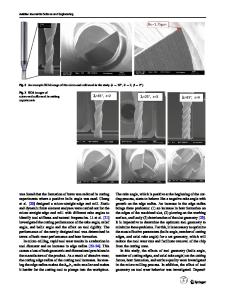Precision distribution design of micro-textured ball-end milling tool and the analysis of its effects on the strength of
- PDF / 1,852,389 Bytes
- 11 Pages / 595.276 x 790.866 pts Page_size
- 0 Downloads / 332 Views
ORIGINAL PAPER
Precision distribution design of micro‑textured ball‑end milling tool and the analysis of its effects on the strength of the insert Xin Tong1 · Xianli Liu1 Received: 12 October 2019 / Accepted: 29 July 2020 © Springer-Verlag France SAS, part of Springer Nature 2020
Abstract Most prior studies have not carried out a precise theoretical analysis and design of micro textures and have thus only conducted experimental analyses of cutting performance that lack theoretical analysis and reliability. This study thus first determined the specific micro-textured application area from a theoretical point of view, based on the contact relationship between the rake face and the chip. Secondly, the micro-textured distribution laws were determined for this area along with a definition of the distribution boundaries of the micro textures. Thirdly, the influence of cutting depth on the number of micro-textured rows and columns was analyzed, and these optimized numbers were thus obtained. Finally, the influence of the micro-textured distribution on the strength of the insert was simulated and analyzed. The results showed that the application of micro textures had no significant effect on the strength of the tool. The results of the research ensured consistency for subsequent research into the milling performance of micro-textured ball-end milling tools. Keywords Ball-end milling tool · Micro textures · Precise distribution design · Strength · Insert
1 Introduction Precision design of micro textures is a precondition for studying the cutting performance of micro-textured ball-end milling tools. The precision of the design will directly affect the surface quality and the strength of the tool and will seriously affect the surface quality of the workpiece. At present, most studies have not theoretically described the precise design of the micro textures and have only analyzed the cutting performance of the tools using experimental methods. Therefore, a theoretical analysis of the specific placement area of the micro-pit textures was conducted in this study. This included an analysis of the distribution laws of the micro-pit textures in this area, the relationship between the cutting depth and the distribution of the micro-pit textures, and the influence of the micro-pit texture distribution on the strength of the tool. This analysis ensured the consistency of
* Xin Tong [email protected] Xianli Liu [email protected] 1
Harbin University of Science and Technology, Harbin 150080, China
subsequent research into the milling performance of microtextured ball-end milling tools. Professor Jianxin et al. took the lead in the design and development of a new self-lubricating tool by incorporating micro textures in the tool and by comparing it with conventional tools. The mechanisms associated with anti-friction and anti-wear were also further analyzed in this study. Preparing the concave or groove textures on the rake face of micro-textured tools with solid lubricant played a role in promoting anti-friction and anti-wear
Data Loading...










